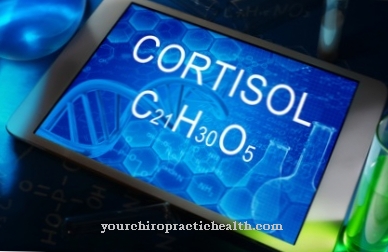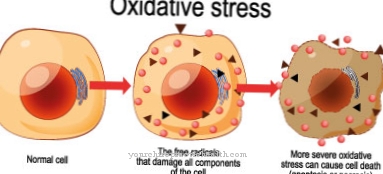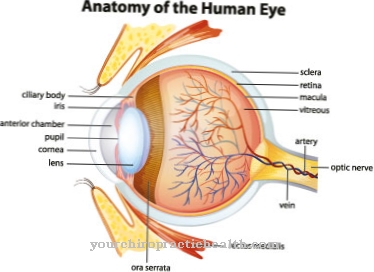Atypical facial pain or persistent idiopathic facial pain is a permanent, burning or throbbing pain, usually on one side of the face. The special thing about this disease is the lack of a recognizable cause. The diagnosis is very complex, the treatment consists of medicinal and therapeutic measures.
What is Atypical Facial Pain?
.jpg)
© estradaanton - stock.adobe.com
Atypical facial pain refers to persistent pain in the face that cannot be assigned to the known facial neuralgia. The term was coined in the early 20th century to distinguish the disease from the typical facial pain caused by nerve disorders.
Today, the term persistent idiopathic (i.e. without an identifiable cause) facial pain is also common. Atypical facial pain is characterized by persistent, burning or pressing pain, sometimes perceived as pulsating and piercing. It usually only affects one half of the face, rarely both sides, and often remains very painful for a long period of time.
In between, several weeks or months can be completely symptom-free. A physical cause cannot be identified, and the facial region of the pain usually cannot be precisely defined. However, the area around the upper jaw is often painful. Atypical facial pain sufferers are mainly women between the ages of 30 and 60; they make up about two thirds of the patients.
causes
The causes of the atypical facial pain are still unknown. On the one hand, one suspects an interaction with mental disorders, because many of those affected suffer from depression [or psychoses. These mental illnesses arise, among other things, from a disturbed household of neurotransmitters in the brain, which was also found in patients with atypical facial pain.
Other possible causes are stress, anxiety or other psychological stress. However, this is not clearly clarified. The atypical facial pain often begins after minor procedures at the dentist. However, a direct physical connection between the tooth nerves and the atypical facial pain is also not recognizable.
Symptoms, ailments & signs
With this condition, patients primarily suffer from severe facial pain. The pain occurs in different regions and is described as piercing, stabbing or even burning. Often it does not occur permanently, but only irregularly. During the night, facial pain can lead to severe sleep problems and thus to psychological upset or depression.
Many patients appear irritated by the pain. The pain also spreads to the jaw, nose and eyes. The temples and cheeks can also be affected by the pain. Those affected often suffer from difficulty swallowing and can no longer take food and fluids easily.
Pain in the back or neck often occurs due to facial pain and continues to reduce the quality of life. There are significant restrictions in everyday life and often also movement restrictions.The pain in the face can also lead to headaches and thus cause disturbances in concentration. In some cases, in addition to the pain, paralysis occurs, so that there are disorders of sensitivity in the face.
Diagnosis & course
Atypical facial pain begins with irregular pain in one half of the face, usually in the upper jaw area. It feels piercing, pulsating, pressing or burning. In the further course it occurs daily and manifests itself in different regions of the face. It hurts in the eye, temple, cheek, nose or upper jaw.
The atypical facial pain is permanent and not seizure, as is the case with facial neuralgia. The pain worsens when it is cold. The face feels like there is inflammation. Many sufferers experience a depressive mood along with atypical facial pain, as well as various other physical complaints such as back pain, migraines or neck pain.
Diagnosing atypical facial pain is difficult and very time-consuming. It can only be made in the process of elimination. All possible examinations must first be carried out in order to rule out other diseases. This requires dental and ophthalmological examinations, as well as consultation with an ENT doctor.
If no causes for the facial pain can be found, a neurologist should use further diagnostic procedures to rule out a tumor in the head or a disease of the facial nerve (trigeminal neuralgia). It should also be clarified whether other types of headache, such as migraines or tension headaches, are the cause of the atypical facial pain.
Complications
In most cases, there is very severe pain on the face that cannot be directly linked to a cause. Diagnosis is also relatively complicated, so that treatment is delayed in most cases. The sufferer is severely restricted in his everyday life by the pain and suffers from a reduced quality of life.
Constant pain leads to depression and other psychological complaints for many people. A general aggressive attitude and irritability can also occur and have a negative effect on social contacts. Pain from the face can spread to other regions as well. The head and back are particularly affected.
It is not uncommon for the teeth to hurt and the patient suffers from a migraine. If the pain spreads to the eyes, it can cause visual disturbances. Treatment is usually causal, but primarily can only relieve pain.
Painkillers are used for this. Relaxation exercises or massages can also help relieve facial pain. If the pain occurs due to a psychological cause, treatment by a psychologist is usually necessary.
When should you go to the doctor?
If you suddenly experience unilateral, burning or boring pain in the throat, nose, cheek, temple, eye or jaw that cannot be traced back to a specific cause, we recommend that you see a doctor immediately. The doctor can diagnose the atypical facial pain based on a diagnosis of exclusion or identify another disease as the cause.
Appropriate treatment - usually a combination of stress therapy and antidepressants for atypical facial pain - can then be initiated. If the symptoms remain untreated, further symptoms can arise.
At the latest when the pain becomes chronic or physical symptoms such as migraines, neck pain or back pain occur, you must see a doctor. If the symptoms occur in connection with psychological changes (including depressive moods and psychosomatic disorders), a doctor should be called in immediately.
Medical advice is particularly needed if the atypical facial pain recurs over the course of a few weeks to months and increases in intensity. In addition to medical treatment, behavioral therapy measures and psychological pain therapies can be considered.
Doctors & therapists in your area
Treatment & Therapy
Treating atypical facial pain is not easy. Usually pain relievers are taken first, but this is not a permanent solution. Good experiences have been made with tricyclic antidepressants, which have a beneficial effect on the processing of pain in the brain and also alleviate the frequently occurring psychological complaints.
Antispasmodic drugs promote relaxation and can aid other relaxation methods such as autogenic training or progressive muscle relaxation. Massages can also help. Good experiences have been made with transcutaneous electrical nerve stimulation (TENS). The affected skin areas are treated with electrical stimulation using electrodes in order to generate a counter-stimulus to the pain. This calms the nervous system and activates the body's own pain relieving processes.
Acupuncture has also proven effective in treating atypical facial pain. Since the psyche is always affected, behavior therapy measures or the support of special pain therapists are also recommended.
Outlook & forecast
The healing prospects of atypical facial pain are very individual and depend on the underlying disease. Mostly it is a mental illness. If this is diagnosed and treated by a therapist, the symptoms can improve within a few weeks or months. This depends on the cooperation with the patient, his understanding of the illness and independent cooperation. Under optimal conditions, the patient can be symptom-free within a short time and remain so for life.
The more serious the disease, the more difficult the prognosis. This is particularly the case with chronic illnesses or a lack of insight into the disease. Without therapeutic or medical help, the symptoms are often permanent. In the course of life there can be changes depending on the individual circumstances.
Some patients, with good self-reflection, manage to identify and correct the cause on their own. Many find this difficult, which contributes to maintaining or worsening the symptoms. Relaxation techniques and targeted stress relief are helpful and improve the prognosis.
The administration of medication can also provide relief. Usually the patient also experiences freedom from symptoms. Often, however, the pain returns suddenly after stopping the drug if the cause has not been corrected.
You can find your medication here
➔ Medicines for painprevention
Atypical facial pain cannot be specifically prevented. However, since it usually occurs together with psychological factors, a healthy lifestyle and the avoidance of extreme psychological stress can take precautions. In order to avoid an existing atypical facial pain from worsening, it is imperative to refrain from supposed help through operations in the facial area.
Aftercare
Atypical facial pain is now referred to as persistent idiopathic facial pain. Those affected are first subjected to acute treatment. This is followed by close follow-up support. This includes medical measures such as a pain relieving medication prescription, as well as psychosocial components.
Outpatient follow-up checks and keeping a pain diary are examples of a follow-up therapy concept for persistent idiopathic facial pain. In addition, the prescribed drug dose must be discussed. With persistent pain syndromes such as atypical facial pain, the risk of addiction is particularly high. Sufferers must therefore be familiarized with strategies that enable pain relief without the potential for addiction.
The attitude of the attending physicians is often problematic during aftercare. They usually classify the pain problem as a sign of hypochondria. The reason is that, despite all differential diagnostics, there is no recognizable cause for the atypical facial pain. In addition, women are more often affected than men. Therefore, some attending physicians quickly come to the conclusion that chronic pain conditions would indicate a mental illness.
You can do that yourself
Since the cause of the persistent idiopathic facial pain is still not known, the patient cannot take any self-help measures that have a causal effect.
The pain is probably related to psychological factors such as fear or stress. Here the patient can learn to cope better with such situations. Relaxation techniques such as yoga or autogenic training can be helpful.
If the patient also suffers from depressive moods, which is quite often the case with persistent idiopathic facial pain, a medically prescribed therapy can be gently supported by naturopathic methods. Naturopathy mainly relies on the mood-enhancing effect of St. John's wort.
Appropriate preparations are available as tea, tablets or drops in pharmacies and health food stores. St. John's wort increases the sensitivity to light. Extensive sunbathing should therefore be avoided while this substance is being administered. St. John's wort is also suspected of influencing the effectiveness of the birth control pill. Women using hormonal contraception should consult their gynecologist.
Symptoms such as neck or back pain can be alleviated through exercise or targeted physiotherapeutic exercises. Regular medical massages can also prevent tension-related pain in the neck and shoulder area. In addition, acupuncture has also proven effective for idiopathic facial pain.
























.jpg)



